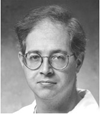Medical Idiocracy*
The following was inspired by the presentation of the ASA president and the SAB plenary session at this year’s AUA meeting. It is reprinted from the Summer 2008 AUA newsletter. http://www.auahq.org/Summer2008.pdf
What a trip! An hour ago I entered the UPenn hyperbaric chamber but there was a power surge and poof! The lights went out, the barometric pressure undulated up down and all over and I found myself in the chamber after the lights came on but different folks were running the unit. I looked at the clock and it was the year 2050! I stepped out to find the tech frantically turning knobs and spinning wheels and trying to figure out what was going on. He did not seem very able as a problem solver.
(The hyperbaric technical society, founded in 2010 and following the lead of the nurses, successfully lobbied and got a law passed in 2020, giving the techs full autonomy to run hyperbaric chambers. The PhD’s all were released. In a repeat of the scenario that occurred with the 20th century steelworkers, most enrolled in nursing school as a pathway to a remunerative, satisfying, autonomous career. Notably, the Journal of Hyperbaric Medicine, receiving an insufficient number of submissions, stopped publishing in 2031.)
Wow! I thought. Its 2050! I couldn’t wait to find out how Anesthesiology had progressed and was eager to check this out. So I ran over to the hospital, now called UPMC-HUP (yes…..UPMC bought the UPenn Health system in 2025) to check things out. I really wanted to observe things in my old neuro rooms.
The neurosurgery advances were just magnificent. The robot worked wonders and all the guess work was gone. The UNIX-versant neurosurgeon put the patient in pins, programmed the computer, and was able to oversee six craniotomies at once. Very cool. But the anesthesia…..the anesthesia was a different matter.
(The many patient safety efforts of visionary
MDA’s that started in the mid 20th century progressed through the
first two decades of the 21st century. The APSF’s work continued with 50 research
grants annually, over 60 patient safety standards in effect, and over 100
instructional patient safety oriented videos in use by 2020. Anesthetic death and morbidity was
approaching zero. However, The AANA,
after a persistent and brilliant lobbying campaign, got a law passed in 2015 which allowed them to
practice independently while concomitantly increasing the number of CRNA and PhD-level
CRNA graduates…all according to their secret strategic plan laid out in 2001
and implemented with little resistance from the highly paid, overworked, and otherwise complacent MDA’s of the early 21st century. The law specifically allowed PhD level CRNAs
to present to patients as their anesthesiologist and their anesthesia
doctor. In addition, over the next five
years, in the context of a catastrophic
health care funding crisis with rampant systemic rationing of resources, the AANA brilliantly and effectively argued that each SRNA was self-funded
and MDA’s were overpaid with no added value, given the spectacular safety
record of anesthesia. Moreover, they
convinced the legislators that it would be in society’s interest to stop
funding all MDA anesthesiology residencies. The federal health care act of 2020 provided
for no funding for MDA training while abolishing anesthesia-related lawsuits. This contributed to the spectacular growth of SRNA
residencies over 2020-30. Third world
health care, already dreadful, became a calamity as nurses from those countries
flocked to the USA
So, my old anesthesia department, august tradition of Dripps, Eckenhoff, and VanDam notwithstanding, was phased out of the medical school in 2030 and now the CRNA PhD’s were running the anesthesia service line. I must admit they ran an efficient operation. Everyone got propofol, vec, and desflurane. All got the same airway management and most of the patients that I saw woke up just fine. I was told there was the occasional stroke and the occasional cardiac arrest and post op MI, and sometimes there was an difficult airway related death. In fact the anesthesia death rate had risen since 2008 and those who did not do well in surgery had a financially mandated withdrawal of support. Things like this were necessary in a world with more beneficiaries than workers; it seemed like these negatives were acceptable cost benefit trade offs in order to keep the federal health service running. Other than that it was just like 2008, but with shorter turnover times.
I found one of these latter day anesthesia doctors so I could have a discussion about what was going on. I was eager to hear about how the nascent issues of 2008 neuroanesthesia had grown. So I asked, what had happened to developments in genomics to tailor anesthesia? What about the new brain protection strategies? Had the new laser IR to support brain ATP been translated? Surely that was in use by neuroanesthesiologists of 2050. What new drugs had been developed? How about blood substitutes? Any new monitors? Any continuous CBF and CMRO2 monitors that were being discussed in 2008? New simulation technology? Had anything changed since 2008?
The anesthesia doctor I spoke with looked askance at me and suggested that there were no significant problems, the surgeons had solved all the important problems and all the stuff I was asking about, after review by the Best Practices Board of the AANA, had been dropped as just expensive fluff stuff. They were doing just fine without it.
So after a week or so in 2050, I headed back to the chamber and hoped the “hey dude” gang could get me back to 2008.
Story line adapted from the new cult movie, “Idiocracy” If you’ve never heard of it learn more from http://www.imdb.com/title/tt0387808/ or http://en.wikipedia.org/wiki/Idiocracy or just google it.
 Mitch Keamy is an anesthesiologist in Las Vegas Nevada
Mitch Keamy is an anesthesiologist in Las Vegas Nevada
 Andy Kofke is a Professor of Neuro-anesthesiology and Critical Care at the University of Pennslvania
Andy Kofke is a Professor of Neuro-anesthesiology and Critical Care at the University of Pennslvania
 Mike O'Connor is Professor of Anesthesiology and Critical Care at the University of Chicago
Mike O'Connor is Professor of Anesthesiology and Critical Care at the University of Chicago
 Rob Dean is a cardiac anesthesiologist in Grand Rapids Michigan, with extensive experience in O.R. administration.
Rob Dean is a cardiac anesthesiologist in Grand Rapids Michigan, with extensive experience in O.R. administration.